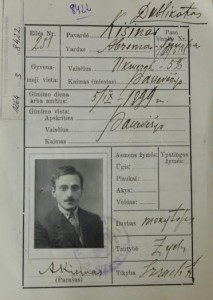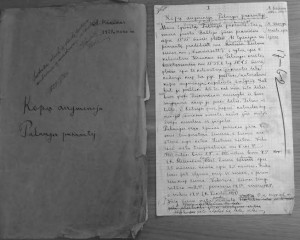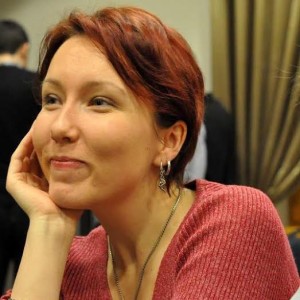Radvilė Rimgailė-Voicik, who writes and compiles the quarterly Bagel Shop newsletter, has had an academic article published by the Israel Journal of Plant Sciences. The article, called “Plant Community Associations and Complexes of Associations in the Lithuanian Seashore: Retrospective on the Studies and Tragic Fate of the Botanist Dr Abromas Kisinas (1899–1945),” pursues the topic Radvilė wrote about in a previous issue of the Bagel Shop newsletter.
Abstract:
The life and scientific activities and discoveries of Dr Abromas Kisinas (1899–1945, also appearing in the literature as Avraham, Abraham, Kisin or Kissin) are presented here for the first time. He was a botanist, a Lithuanian, a graduate of Vytautas Magnus University in Kaunas, a polyglot and a social figure. In 1936, Kisinas’ major phytosociological work “Plant Associations and Complexes of Associations in Lithuanian Seaside (without Klaipėda Region)” was published in the Works of Vytautas Magnus University Faculty of Mathematics and Natural Sciences. The publication was written in Lithuanian with a summary in German and summarized Kisinas’ PhD dissertation, which was defended in 1934 under the supervision of Prof. Constantin Regel. In his research, Kisinas applied ideas proposed by the Uppsala School of Phytosociology. For plant communities evaluation he used linear transects with 1 m², 4 m² and 16 m² sampling squares. In a 15 km seashore range Kisinas determined 63 plant community associations and 26 sub-associations. The fate of this gifted scientist was tragic. In 1941 he and his family were deported to the Kaunas Ghetto. In 1945 Kisinas died at the Dachau concentration camp in Germany.


In issue no. 1 for the 2015 volume of the Bagel Shop newsletter, Radvilė wrote:
Another exceptional personality whose collected plant specimens are conserved at the Vilnius University Herbarium was Avrom Simkha Kisin. He was born in 1899 to Jakov and Khaya in Panevėžys, Lithuania. He began to teach in 1918 and worked as a teacher his entire life, with some interruptions. He was highly interested in the Hebrew language. He was an active member of social and political organizations and belonged to the Lithuanian Socialist Zionist Party’s central committee. He was part of the editorial board the Yiddish-language Dos Vort [The Word] newspaper. He also edited the publication of the Lithuanian Union of Hebrew Language Teachers called Be’Mish’oley haKhinukh [Ways of Education] and was chairman of the organization as well as vice-principal of a gymnasium. Professor Konstantinas Regelis encouraged the talented student to begin work on the vegetation growing on sand on the coast of the Baltic Sea. In 1925 and 1926 Kisin did study the vegetation of the coast and summarized his findings in the work he successfully defended in 1927 called “Flora of the Dunes on the Palanga Shore,” which was published in the Lithuanian magazine Kosmos, which popularized the scientific achievements of that period. Kisin continued to do work on the coastal plant associations and association complexes, and wrote and defended a doctoral dissertation on this subject in 1934.
In 1941 Dr. Kisin, his pediatrist wife Pesia and their daughter Avivit were imprisoned in the Kaunas ghetto. It is known Dr. Kasin was one of four Jewish polyglots selected by the Rosenberg task force for inventorying books and Judaica seized by the Nazis in Kaunas and scheduled to be sent to Germany.
It is highly likely Dr. Kisin continued to be an active participant in underground Zionist activities inside the ghetto. When the Kaunas ghetto was liquidated in 1944 the botanist was sent to the Kaufering concentration camp in the Dachau complex of camps, where he died in 1945, just two months before liberation. His wife Pesia and daughter Avivit survived and remained grateful for the rest of their lives to the family of professor Tadas Petkevičius and to Bronislovas and Juozas Paukštys. In one issue of Nitzotz—the only Hebrew publication in the Dachau complex—there is a text by Mendel Sodovsky entitled “Thirty Days after the Death of Avrom Kisin.” Sodovsky wrote of his teacher: “Never in my life will I forget your black eyes, the eyes of a teacher, a searcher and a leader. You were strict not just with us, your students, but with yourself. … You never stopped enriching your students with knowledge, and never stopped getting them to know nature and the living world more closely. You are always collecting specimens of plants and animals, and you save every little blade of grass you find. And you were determined, undeterrable, like your Jewish nature. It wasn’t enough for you just to discover a plant, you experimented with it, and gave it a name, not just any old name, but a new-old name from the Bible. Nature… and Hebrew. In the Hebrew language your world was without limit. Your death is the loss of your people, the loss of a good and loyal son. And the Zionist movement has lost one of its remaining pioneers, a man of ideas and a loyal friend, who always worked and encouraged the youth to fight for their homeland, for Israel.”
For more on the new academic article, see here:
http://www.tandfonline.com/doi/full/10.1080/07929978.2016.1154320



